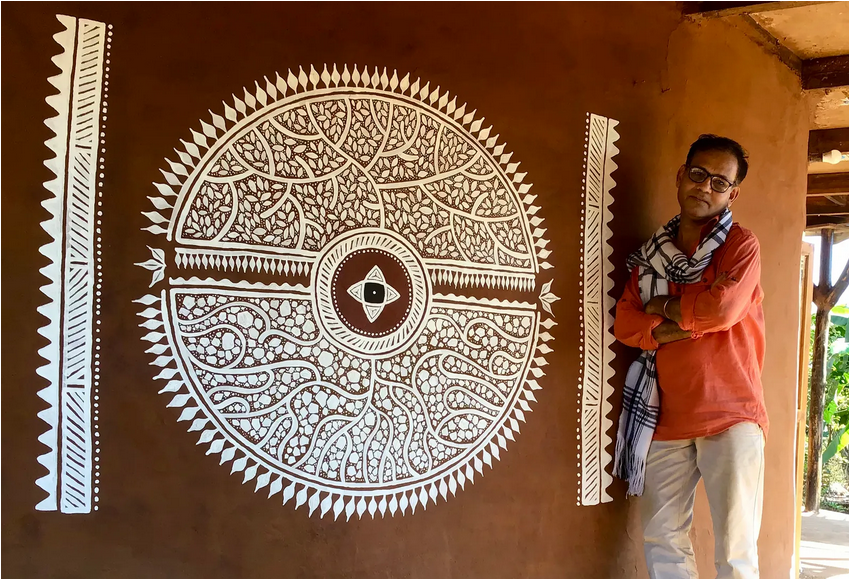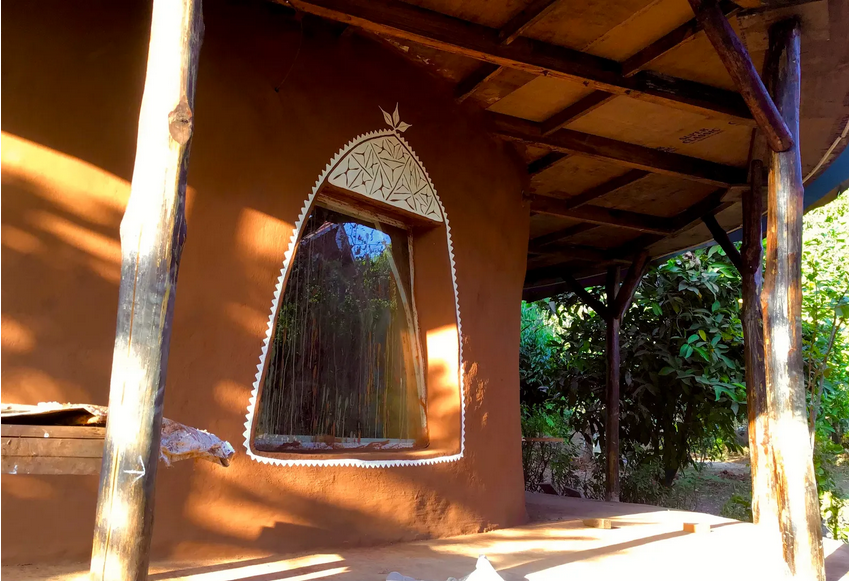Kiran Amati and his father, Prakash, spent most weekends farming, and experimenting with dairy and cow dung products on Prakash’s farm outside of Mumbai, India. At some point, Amati and his father chanced upon “Geeli Mitti,” an organization that leads workshops on natural buildings. Eventually, with the help of Geeli Mitti and a group of enthusiastic volunteers, the two built their own Cob House on a plot opposite their farm, using straw, clay, local soil, stone, cow dung, and lime. The two-story circular house was then beautified with murals in the Rajasthani folk tradition.
 The Cob House is a circular, studio-style space with the living quarters on the ground floor, and a small ‘meditation room’ above. There’s an additional six-foot verandah on the ground floor, and a balcony of equal size attached to the upper story. The interiors are furnished with a sofa made out of mud, a study table ingrained in the wall and a circular mud bed.
The Cob House is a circular, studio-style space with the living quarters on the ground floor, and a small ‘meditation room’ above. There’s an additional six-foot verandah on the ground floor, and a balcony of equal size attached to the upper story. The interiors are furnished with a sofa made out of mud, a study table ingrained in the wall and a circular mud bed.
 Geeli Mitti had taught Amati an intuitive and rather quirky technique of spatial planning. “I would go to the site, and just go through my daily routine,” says Amati. “At first I thought it was a little silly, but it really allows you to move according to your convenience–see where you want to sit, where you want to sleep, where you want to eat, and then design the house around that.” The home has no partitions; there is a kitchen counter, and storage inside the walls for big utensils, plus cabinets under the counter for smaller equipment.
Geeli Mitti had taught Amati an intuitive and rather quirky technique of spatial planning. “I would go to the site, and just go through my daily routine,” says Amati. “At first I thought it was a little silly, but it really allows you to move according to your convenience–see where you want to sit, where you want to sleep, where you want to eat, and then design the house around that.” The home has no partitions; there is a kitchen counter, and storage inside the walls for big utensils, plus cabinets under the counter for smaller equipment.
 A bright white painting on the circular wall to the left of the entrance depicts the story of the destruction of nature, while a visual depiction of the “tree of life” is meant to manifest the “tantra impulses of inner revival.”
A bright white painting on the circular wall to the left of the entrance depicts the story of the destruction of nature, while a visual depiction of the “tree of life” is meant to manifest the “tantra impulses of inner revival.”
 In the spiritual study room on the upper floor, the circular wall depicts the “Tantra of inner awakening,” showcased through the low bas-relief clay work made from a mixture of local clay, cow dung, dried grass, natural gum and a paste of neem leaves. All these visual manifestations are connected to a story of Prakriti—nature—and Shakti, the energy that flows through nature.
In the spiritual study room on the upper floor, the circular wall depicts the “Tantra of inner awakening,” showcased through the low bas-relief clay work made from a mixture of local clay, cow dung, dried grass, natural gum and a paste of neem leaves. All these visual manifestations are connected to a story of Prakriti—nature—and Shakti, the energy that flows through nature.
 While Amati had never intended for his humble Cob House to be as ornamented as it is now, he hopes that it will inspire more people to build their own homes. “You will have ups and downs,” he admits, “It’s obviously not skilled or fine work. If someone comes in with a very neat eye, someone like an architect, they’ll be able to find mistakes in what we did.” But for Amati, those imperfections are part of what makes the home special. A segment where the wall plaster happens to be perfectly even reminds him of a day when his team was in a good mood; conversely, a spot of aggressively applied polish reminds him of a fight he had with his father. “We know when we had a fight, and we know when we had disagreements, we know when we were having fun,” he says, “The house is full of memories of us building it.”
While Amati had never intended for his humble Cob House to be as ornamented as it is now, he hopes that it will inspire more people to build their own homes. “You will have ups and downs,” he admits, “It’s obviously not skilled or fine work. If someone comes in with a very neat eye, someone like an architect, they’ll be able to find mistakes in what we did.” But for Amati, those imperfections are part of what makes the home special. A segment where the wall plaster happens to be perfectly even reminds him of a day when his team was in a good mood; conversely, a spot of aggressively applied polish reminds him of a fight he had with his father. “We know when we had a fight, and we know when we had disagreements, we know when we were having fun,” he says, “The house is full of memories of us building it.”
 You can read the original article at www.architecturaldigest.in
You can read the original article at www.architecturaldigest.in

